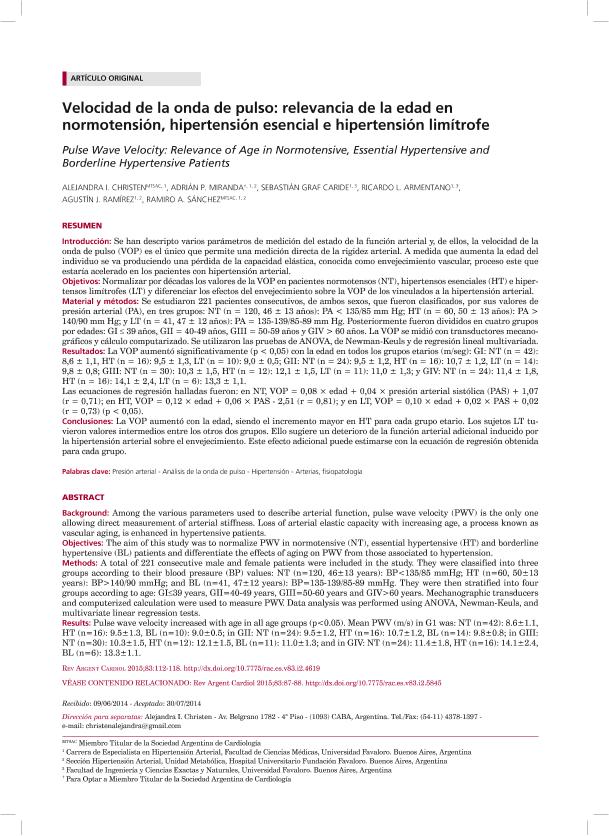Mostrar el registro sencillo del ítem
dc.contributor.author
Christen, Alejandra I.
dc.contributor.author
Miranda, Adrian P.
dc.contributor.author
Graf Caride, Diego Sebastián

dc.contributor.author
Armentano, Ricardo Luis

dc.contributor.author
Ramírez, Agustín José

dc.contributor.author
Sánchez, Ramiro A.
dc.date.available
2018-07-16T17:29:16Z
dc.date.issued
2015-05
dc.identifier.citation
Christen, Alejandra I.; Miranda, Adrian P.; Graf Caride, Diego Sebastián; Armentano, Ricardo Luis; Ramírez, Agustín José; et al.; Velocidad de la onda de pulso: relevancia de la edad en normotensión, hipertensión esencial e hipertensión limítrofe; Sociedad Argentian de Cardiología; Revista Argentina de Cardiología; 83; 1; 5-2015; 112-118
dc.identifier.issn
1850-3748
dc.identifier.uri
http://hdl.handle.net/11336/52211
dc.description.abstract
Introducción: Se han descripto varios parámetros de medición del estado de la función arterial y, de ellos, la velocidad de la onda de pulso (VOP) es el único que permite una medición directa de la rigidez arterial. A medida que aumenta la edad del individuo se va produciendo una pérdida de la capacidad elástica, conocida como envejecimiento vascular, proceso este que estaría acelerado en los pacientes con hipertensión arterial. Objetivos: Normalizar por décadas los valores de la VOP en pacientes normotensos (NT), hipertensos esenciales (HT) e hipertensos limítrofes (LT) y diferenciar los efectos del envejecimiento sobre la VOP de los vinculados a la hipertensión arterial. Material y métodos: Se estudiaron 221 pacientes consecutivos, de ambos sexos, que fueron clasificados, por sus valores de presión arterial (PA), en tres grupos: NT (n = 120, 46 ± 13 años): PA < 135/85 mm Hg; HT (n = 60, 50 ± 13 años): PA > 140/90 mm Hg; y LT (n = 41, 47 ± 12 años): PA = 135-139/85-89 mm Hg. Posteriormente fueron divididos en cuatro grupos por edades: GI ≤ 39 años, GII = 40-49 años, GIII = 50-59 años y GIV > 60 años. La VOP se midió con transductores mecanográficos y cálculo computarizado. Se utilizaron las pruebas de ANOVA, de Newman-Keuls y de regresión lineal multivariada. Resultados: La VOP aumentó significativamente (p < 0,05) con la edad en todos los grupos etarios (m/seg): GI: NT (n = 42): 8,6 ± 1,1, HT (n = 16): 9,5 ± 1,3, LT (n = 10): 9,0 ± 0,5; GII: NT (n = 24): 9,5 ± 1,2, HT (n = 16): 10,7 ± 1,2, LT (n = 14): 9,8 ± 0,8; GIII: NT (n = 30): 10,3 ± 1,5, HT (n = 12): 12,1 ± 1,5, LT (n = 11): 11,0 ± 1,3; y GIV: NT (n = 24): 11,4 ± 1,8, HT (n = 16): 14,1 ± 2,4, LT (n = 6): 13,3 ± 1,1. Las ecuaciones de regresión halladas fueron: en NT, VOP = 0,08 × edad + 0,04 × presión arterial sistólica (PAS) + 1,07 (r = 0,71); en HT, VOP = 0,12 × edad + 0,06 × PAS - 2,51 (r = 0,81); y en LT, VOP = 0,10 × edad + 0,02 × PAS + 0,02 (r = 0,73) (p < 0,05). Conclusiones: La VOP aumentó con la edad, siendo el incremento mayor en HT para cada grupo etario. Los sujetos LT tuvieron valores intermedios entre los otros dos grupos. Ello sugiere un deterioro de la función arterial adicional inducido por la hipertensión arterial sobre el envejecimiento. Este efecto adicional puede estimarse con la ecuación de regresión obtenida para cada grupo.
dc.description.abstract
Background: Among the various parameters used to describe arterial function, pulse wave velocity (PWV) is the only oneallowing direct measurement of arterial stiffness. Loss of arterial elastic capacity with increasing age, a process known asvascular aging, is enhanced in hypertensive patients.Objectives: The aim of this study was to normalize PWV in normotensive (NT), essential hypertensive (HT) and borderlinehypertensive (BL) patients and differentiate the effects of aging on PWV from those associated to hypertension.Methods: A total of 221 consecutive male and female patients were included in the study. They were classified into threegroups according to their blood pressure (BP) values: NT (n=120, 46±13 years): BP<135/85 mmHg; HT (n=60, 50±13years): BP>140/90 mmHg; and BL (n=41, 47±12 years): BP=135-139/85-89 mmHg. They were then stratified into fourgroups according to age: GI<40 years, GII=40-50 years, GIII=50-60 years and GIV>60 years. Mechanographic transducersand computerized calculation were used to measure PWV. Data analysis was performed using ANOVA, Newman-Keuls, andmultivariate linear regression tests.Results: Pulse wave velocity increased with age in all age groups (p<0.05). Mean PWV (m/s) in G1 was: NT (n=42): 8.6±1.1,HT (n=16): 9.5±1.3, BL (n=10): 9.0±0.5; in GII: NT (n=24): 9.5±1.2, HT (n=16): 10.7±1.2, BL (n=14): 9.8±0.8; in GIII:NT (n=30): 10.3±1.5, HT (n=12): 12.1±1.5, BL (n=11): 11.0±1.3; and in GIV: NT (n=24): 11.4±1.8, HT (n=16): 14.1±2.4,BL (n=6): 13.3±1.1.Regression equations were: for NT, PWV=0.08 × age+0.04 × systolic blood pressure (SBP)+1.07 (r=0.71); for HT, PWV=0.12× age+0.06 × SBP-2.51 (r=0.81); and for BL, PWV=0.10 × age+0.02 × SBP+2.90 (r=0.73) (p<0.05).Conclusions: Pulse wave velocity increased with age, and was higher in HT patients for each age group. Borderline hypertensivepatients presented intermediate values between the other two groups. These results suggest additional vascular impairmentinduced by hypertension over that of aging. This surplus effect could be estimated from the regression equation obtainedfor each group.
dc.format
application/pdf
dc.language.iso
spa
dc.publisher
Sociedad Argentian de Cardiología
dc.rights
info:eu-repo/semantics/openAccess
dc.rights.uri
https://creativecommons.org/licenses/by-nc-sa/2.5/ar/
dc.subject
Presión Arterial
dc.subject
Análisis de La Onda de Pulso
dc.subject
Hipertensión
dc.subject
Arterias
dc.subject.classification
Medicina Critica y de Emergencia

dc.subject.classification
Medicina Clínica

dc.subject.classification
CIENCIAS MÉDICAS Y DE LA SALUD

dc.title
Velocidad de la onda de pulso: relevancia de la edad en normotensión, hipertensión esencial e hipertensión limítrofe
dc.title
Pulse Wave Velocity: Relevance of Age in Normotensive, Essential Hypertensive and Borderline Hypertensive Patients
dc.type
info:eu-repo/semantics/article
dc.type
info:ar-repo/semantics/artículo
dc.type
info:eu-repo/semantics/publishedVersion
dc.date.updated
2018-07-13T17:27:30Z
dc.journal.volume
83
dc.journal.number
1
dc.journal.pagination
112-118
dc.journal.pais
Argentina

dc.description.fil
Fil: Christen, Alejandra I.. Universidad Favaloro; Argentina
dc.description.fil
Fil: Miranda, Adrian P.. Universidad Favaloro; Argentina
dc.description.fil
Fil: Graf Caride, Diego Sebastián. Universidad Favaloro; Argentina. Consejo Nacional de Investigaciones Científicas y Técnicas; Argentina
dc.description.fil
Fil: Armentano, Ricardo Luis. Universidad Favaloro; Argentina
dc.description.fil
Fil: Ramírez, Agustín José. Universidad Favaloro; Argentina. Consejo Nacional de Investigaciones Científicas y Técnicas; Argentina
dc.description.fil
Fil: Sánchez, Ramiro A.. Universidad Favaloro; Argentina
dc.journal.title
Revista Argentina de Cardiología
dc.relation.alternativeid
info:eu-repo/semantics/altIdentifier/doi/http://dx.doi.org/10.7775/rac.es.v83.i2.4619
dc.relation.alternativeid
info:eu-repo/semantics/altIdentifier/url/http://ppct.caicyt.gov.ar/index.php/rac/article/view/4619
Archivos asociados
